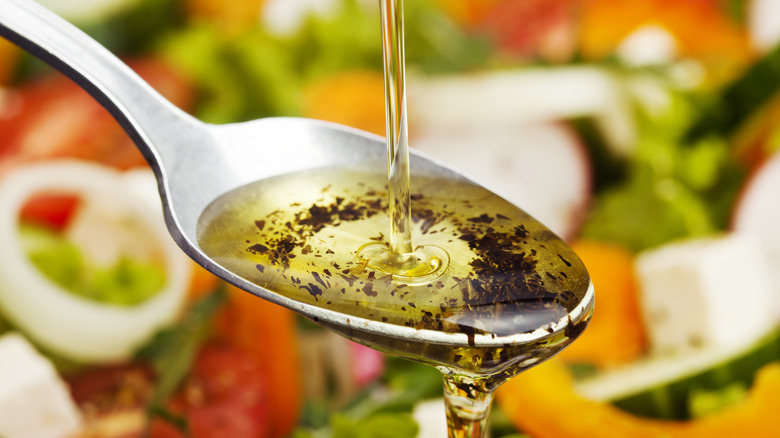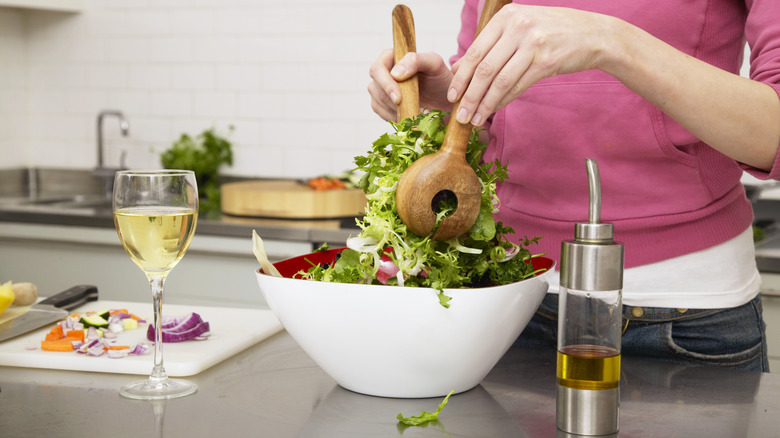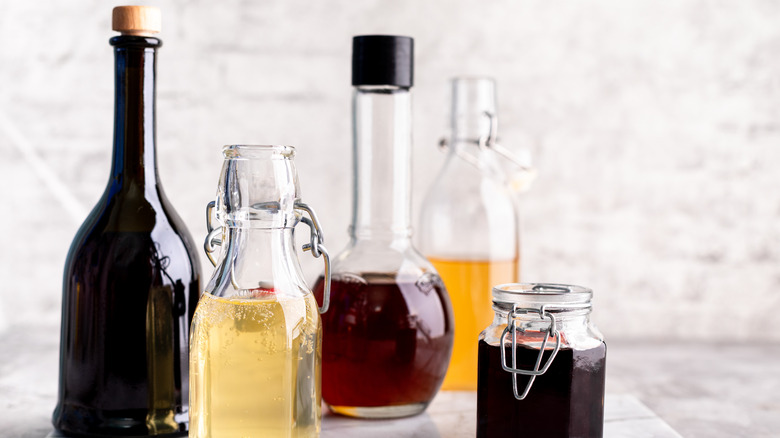Elevate Mediocre Salad Dressing With A Boozy Ingredient
Making homemade salad dressing is easy. A vinaigrette is just a ratio of oil to vinegar (usually 3-to-1), maybe with a flavor boost from some garlic or shallots or spices or held together with a dollop of Dijon mustard. With so few ingredients, how good it is depends on the quality of those ingredients. If you use cheap vinegar, it will have plenty of acidity but little depth of flavor. The good news is that you can hack together a concoction that tastes much more expensive by adding a little splash of wine.
As a general guideline, try to match the wine with your vinegar to keep things consistent: Red wine with red wine vinegar, white wine with white wine vinegar. How much you should add will depend entirely on how big a batch you're making, but it shouldn't be a substantial ingredient. Use a few drops in a single serving, a splash in a double batch, and up to a tablespoon in family-size salads. It doesn't take much wine to boost the flavor of your vinegar; adding too much can throw off the balance of your salad dressing.
You're not aiming for a wine-forward dressing, just a little something-something in the background that makes you say, "Oh, this is better than usual." By simply whisking some wine in with the other ingredients of your salad dressing, it becomes something elevated to bring your meal to another level.
How to pair wine with vinegar
For the best results, consider what flavors you want to introduce and highlight in your salad. Like pairing wine with food, cooking with the bottle you plan to drink with your meal is an easy way to keep things consistent. To fine-tune the dressing, match the flavors in the wine with what's going into your salad.
To make a fall salad with apples and pears, grab a bottle of chardonnay or chenin blanc to highlight the fruit notes. For a summer salad with a lemony zing, a pinot gris/grigio from cooler regions will have zesty notes. If you're serving a salad alongside some tropical flavors, sauvignon blanc can feature passion fruit notes. For a salad with briny ingredients, like olives or oysters, an albariño has mineral background notes to echo their salinity.
Red wines often have berry and dark stone fruit notes, lending a round sweetness to your vinegar. However, they also have unique flavors to back them up. For example, cabernet franc has notes of green bell pepper and herbs. Merlot has notes of bay leaf. Therefore, you can use either in a Greek vinaigrette. Zinfandel has a smokiness to it from the flavors of sweet tobacco, and an aged pinot noir can get mushroomy. For cheap balsamic vinegar, you can go in one of two directions: Sangiovese for its sweet balsamic and espresso notes or a fortified wine, like port, to enhance the sweet stickiness of an aged balsamic.
Why does wine work?
The reason wine works to amplify a homemade vinaigrette comes down to how vinegar is made. Wine vinegars (white wine vinegar, red wine vinegar, champagne vinegar, rice wine, sherry, etc.) are so named because they're made from wine. If you've ever noticed an old, open bottle of wine getting acidic, it's because the oxygenation and bacterial cultures in the environment are starting to turn it to vinegar. Therefore, adding a little wine from that week-old bottle to your salad dressing makes you a gourmet vinegar maker.
That's how the favored vinegar of Michael Harlan Turkell, author of "Acid Trip," has been made for 400 years. As Turkell told New York Magazine, when wines were being shipped via the Loire River back in the day, some would inevitably turn bad. The entrepreneurial types in the town of Orléans would make the spoiled wine left behind into vinegar.
Wine vinegar is made by fermenting wine with an acetic bacterial culture called a mother, which you may be familiar with from kombucha or bottles of raw apple cider vinegar. In the case of making wine, fermentation makes alcohol — but in the case of vinegar, fermentation makes acetic acid; that's what makes it acidic. The better the wine, the better the vinegar. That's why adding a little bit of good wine, even if it's past its drinking prime, works so well to boost the flavor of your vinegar-based salad dressings.


